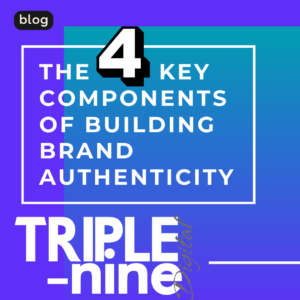
Brand authenticity is important in marketing because it helps build trust with customers. When a brand is perceived as authentic, customers are more likely to believe in the promises it makes, feel a stronger emotional connection to the brand, and become loyal repeat customers. In today’s world, where consumers have access to a lot of information about products and companies, authenticity is becoming increasingly important as a way for brands to differentiate themselves and stand out in a crowded marketplace.
It is only through four key components that brands can have total authenticity. Let’s explore how brands can establish authenticity with their customers. You’ll notice in the examples below that there are a lot of similar message points. All of these components need to work together to create the whole brand, which is why the similarities are so important.
Continuity is when a brand is faithful to itself. A brand was started with an idea, a value, a mission, a choice to fight for something or because of a desire. When customers value what the brand is putting forward, everything should align and support should continue for the long run. Continuity in branding refers to the consistency of a brand’s messaging, visual identity, and overall tone across various channels and over time. It helps to establish brand recognition and loyalty among customers.
A brand can have positive continuity by:
Some examples of continuity in marketing could include:

Honesty is the number one policy. Being honest with your audiences should be an important component for any brand. Otherwise, when a brand gets caught in a dishonest position, all of their hard work to build the brand up will come tumbling down. Credibility leads to transparency which leads to everyone being able to understand what the brand stands for. Focusing on your business’s “why” can help inspire missions and values that customers can relate to. Having those relationships outside of sales helps to have consumers continuously show up to support you, even without making a purchase.
There are a few ways companies can be honest with their customers, such as:
It is important to care about customers and take responsibility as it can lead to increased customer satisfaction, loyalty, and trust. Taking responsibility can prevent negative consequences and improve overall business reputation. Brand integrity in marketing refers to the consistent representation of a brand’s values, messaging, and image across all marketing channels. Here are a few examples of how brands maintain their integrity in marketing:
Symbolism can be a powerful tool for a brand to connect with consumers and allow them to express their identity through the brand. By using symbolism, a brand can create a deeper emotional connection with its customers. It allows consumers to identify with the brand’s values and beliefs, which can make them feel like they are a part of something bigger. This can lead to increased loyalty and advocacy for the brand.
Some examples of successful brand symbolism include Nike’s “swoosh” logo, which represents movement and athleticism, and Apple’s bitten apple, which symbolizes knowledge and innovation. These symbols have become instantly recognizable and have helped to define the brand’s identity. When using symbolism, it’s important for a brand to consider its target audience and ensure that the symbol resonates with them. It should also be unique and easily distinguishable from other brands in the market. With the right approach, symbolism can be a powerful tool for a brand to connect with its consumers and build a loyal following.

Of course this is going to differ between what your personal feelings and beliefs are, but for the sake of this, we will look at campaigns that had great success when connecting with their consumers on a level beyond sales.
Brand authenticity is crucial in establishing a strong relationship with customers. When a business is perceived as authentic, it can increase customer loyalty and trust, which can lead to long-term success. When a brand is authentic, it means that it is true to its values, mission, and promises, which creates a sense of transparency and honesty. Customers are more likely to engage with and support a brand that they feel is authentic, leading to increased customer satisfaction and ultimately, business success.
To assess your brand authenticity, you can review factors such as the consistency of your brand messaging and actions, the transparency of your business practices, and the alignment of your brand values with those of your target audience. It’s also important to listen to feedback from customers and address any concerns or issues promptly and honestly. As and always, you can reach out to our team to discuss how we may be able to help!